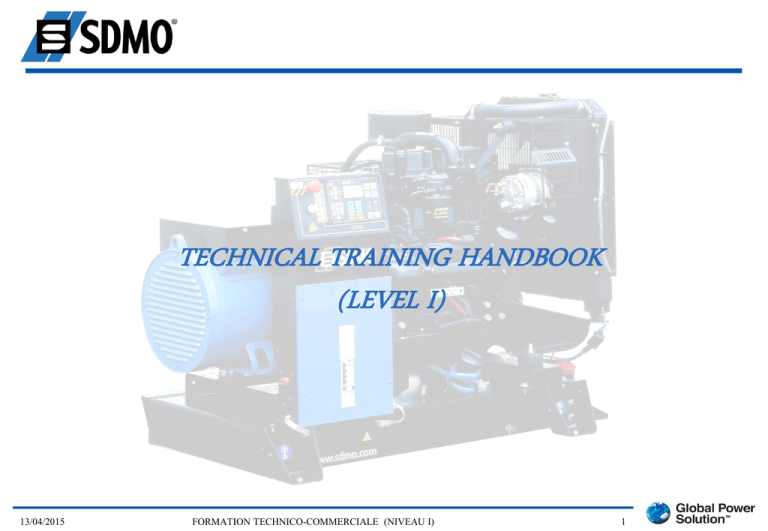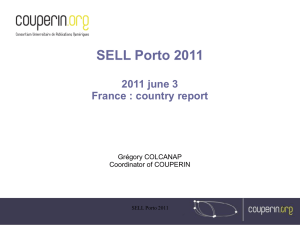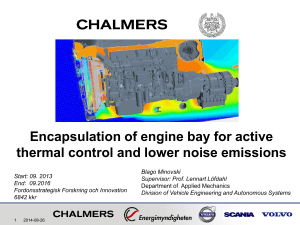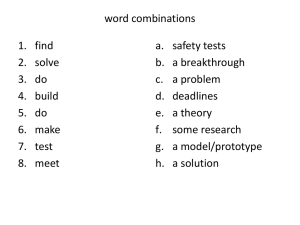1-Training
advertisement

TECHNICAL TRAINING HANDBOOK (LEVEL I) 13/04/2015 FORMATION TECHNICO-COMMERCIALE (NIVEAU I) 1 CONTENTS Introduction First part : basic principles •Magnetic fields •Creation of one sinusoid •Frequency formula •Number of phases •Three phases alternators •Three phases sinusoides •A few formula to remember •Intensity •Power factor cos •Active power / Apparent power •Electric power / mechanic power •Mechanic power •Various types of power 13/04/2015 Page 11 Page 12 Page 13 Page 14 to 15 Page 16 Page 17 Page 18 Page 19 Page 20 Page 21 to 22 Page 23 Page 24 to 25 Page 26 FORMATION TECHNICO-COMMERCIALE (NIVEAU I) 2 CONTENTS Second part : the engine •Various types of engine •Diesel engine •Air circuit •Cooling circuit •Water cooling circuit •Various water cooling systems •Gasoil supply circuit •Various types of intake •Pre-heating •Suspensions •Speed regulation •Electronic speed regulation •Diesel engine lubrification •Engine securities •Engine output 13/04/2015 Page 28 Page 29 to 30 Page 31 Page 32 Page 33 Page 34 to 36 Page 37 to 39 Page 40 to 44 Page 45 Page 46 Page 47 to 48 Page 49 to 51 Page 52 to 53 Page 54 Page 55 FORMATION TECHNICO-COMMERCIALE (NIVEAU I) 3 CONTENTS 3rd Part : the alternator •Exploded view •Voltage regulator •6 threads alternators coupling •12 threads alternators coupling •Electrical connections •Alternator protection Page 57 Page 58 Page 59 Page 60 4th Part : control command •Introduction •Various types of panels •Manual panel •Automatic panel •ATS 13/04/2015 FORMATION TECHNICO-COMMERCIALE (NIVEAU I) Page 61 Page 62 to 63 Page 65 Page 66 Page 67 Page 68 to 69 Page 70 4 CONTENTS 5th Part : Various notions •Installation •Noise Page 72 to 76 Page 77 to 78 Questions 13/04/2015 FORMATION TECHNICO-COMMERCIALE (NIVEAU I) 5 13/04/2015 FORMATION TECHNICO-COMMERCIALE (NIVEAU I) 6 WHAT IS A GENERATING SET ? + ENGINE 13/04/2015 + ALTERNATOR FORMATION TECHNICO-COMMERCIALE (NIVEAU I) CONTROL COMMAND 7 PRESTATIONS DE SDMO INDUSTRIES ENTRIES AIR INSTALLATION EXHAUST ENGINE EXHAUST AIR WATER Ventilation Cooling FUEL Speed regulation PETROL GAZOIL GAZ FRAME POSITION CONNECTION Customer Installator ALTERNATOR CONTROL OUTPUT LOAD S P E E D Ventilation FREQUENCY Voltage regulation VOLTAGE Manufacturer Manufacturer Engine safeties Alternator safeties Amps KW Circuit breaker control or ATS cos phi normal/standby Manufacturer S.D.M.O. 13/04/2015 FORMATION TECHNICO-COMMERCIALE (NIVEAU I) 8 Customer MAGNETIC FIELDS The magnetic field created by the rotating magnet cuts the coils leading to induced current. The flux direction changes (alternates) once per rotation thus creating ALTERNATIVE POWER. The number of times this is happening per second is called FREQUENCY. 13/04/2015 FORMATION TECHNICO-COMMERCIALE (NIVEAU I) 9 MAIN FUNCTIONS In case of mains failure The generating set is an element of assistance replacing the faulty mains and ensuring operating of vital functions of one company, one store or one hospital… When there is no network It is used as the unique energy production source on one construction site, within one works or in the desert… 13/04/2015 FORMATION TECHNICO-COMMERCIALE (NIVEAU I) 10 13/04/2015 FORMATION TECHNICO-COMMERCIALE (NIVEAU I) 11 CREATION OF ONE SINUSOIDE Rotor rotation degrees 13/04/2015 FORMATION TECHNICO-COMMERCIALE (NIVEAU I) 12 FREQUENCY FORMULA Unlike the continuous current (supplied by a battery), the ALTERNATIVE current reverses its polarities + and – 50 times / second, thus obtaining a frequency of 50 Hz (or 60 times in 60 Hz). Formula to remember : F Frequency (Hz) = Number of poles pairs (P) x rotation speed (rp/s.) If number of poles = 4 (2 pairs) Then : Engine speed = 1500 rp/mn F = 2 x 1500 60 sec. n P = If number of poles = 2 (1 pair) Then : Engine speed = 3000 rp/mn = 50 Hz F = 1 x 3000 = 60 sec. The frequency is constant. The number of poles is constant. A genset must operate with a constant speed Importance of the frequency stability. 13/04/2015 FORMATION TECHNICO-COMMERCIALE (NIVEAU I) 13 50 Hz SHAPE OF ONE SINUSOÏDE Positive maximum voltage Negative maximum voltage 1 period 50 ou 60 per second 1 Hz = one period / second 50 Hz = 50 periods / second 13/04/2015 FORMATION TECHNICO-COMMERCIALE (NIVEAU I) 14 NUMBER OF PHASES We can distinguish alternators according to the number of phases : SINGLE PHASE ALTERNATORS : Fitted with coils so that the output voltage is obtained in two terminal points. THREE PHASES ALTERNATORS : Fitted with 3 independent groups of coils un-phased by 120° between each others. 13/04/2015 FORMATION TECHNICO-COMMERCIALE (NIVEAU I) 15 THREE PHASES ALTERNATORS 13/04/2015 FORMATION TECHNICO-COMMERCIALE (NIVEAU I) 16 THREE PHASES SINUSOIDES 1 period Dephased 13/04/2015 FORMATION TECHNICO-COMMERCIALE (NIVEAU I) 17 A FEW FORMULAS TO REMEMBER VOLTAGE: Potential difference between two threads. It is measured with a voltmeter. INTENSITY : Current passing through one receiver within a given time period. It is measured with an anmeter in series. 13/04/2015 FORMATION TECHNICO-COMMERCIALE (NIVEAU I) Schéma Chute d’eau 18 INTENSITY Contrary to the voltage that must remain stable, intensity varies depending on the requested load. Intensity, in the case of some electrical engines supply, may at the start-up of these engines, become during some milliseconds from 6 to 8 times superior to the nominal intensity. I (Amp.) ID I D = Release intensity I N = Nominal intensity IN t 13/04/2015 FORMATION TECHNICO-COMMERCIALE (NIVEAU I) 19 POWER FACTOR In some cases of utilization (supply of electric engines), the current is « late » compared to the voltage. This « delay » is called the power factor « cos ” and its value is very important for the gensets dimensions. The power factor cos of one electric engine is very different between the starting phase and the nominal phase. U i U Cos d = can reach 0,2 Cos n = 0,8 up to 0,9 0 13/04/2015 /2 2 /3 2 t FORMATION TECHNICO-COMMERCIALE (NIVEAU I) 20 ACTIVE POWER / APPARENT POWER Electrical equipments supplied by the generating set (the « consumers ») do not give back the entire power supplied. One distinguishes then the active power from the apparent power. a) SINGLE PHASED Active power = Apparent power x Power factor Cos kWe = kVA x cos P(kW) = V x I x cos S (kVA) = V x I « V » = Voltage between phase and neutral. b) THREE PHASED Active power = Apparent power x Power factor Cos x 3 P (kW) = U x I x cos x 3 S (kVA) = U x I x 3 « U » = Voltage between phase 13/04/2015 FORMATION TECHNICO-COMMERCIALE (NIVEAU I) 21 ACTIVE POWER / APPARENT POWER Active P. (kW) Apparent P. (kVA) Active power = Apparent power x Power factor Cos P = U x I x cos kWe = kVA x cos 13/04/2015 FORMATION TECHNICO-COMMERCIALE (NIVEAU I) 22 ELECTRIC POWER / MECHANIC POWER Alternators do not transform the entire power supplied. Their performance () is around 0,9. Mechanic power = Electric power : P engine = elec. P. : (kW = kWe : ) 13/04/2015 FORMATION TECHNICO-COMMERCIALE (NIVEAU I) 23 MECHANIC POWER : UNITS The engines power rating is expressed with various units depending on the countries. •In CV (« horse power ») 1 CV = 0,736 kW •In « British horse power » 1 BHP = 0,746 kW 13/04/2015 FORMATION TECHNICO-COMMERCIALE (NIVEAU I) 24 MECHANICAL POWER RATING : CALCULATION OF DEMAND We can determine the requested power for the engine from the demand in electric power P eng. = U x I x cos : Theoretical example : one installation requesting - 500 amps - 380 volts - Power factor 0,8 - Performance 0,9 In Kilowatt : 168,9 kW In HP : 229,5 Cv In « British Horse Power » : 226,4 BHP 13/04/2015 FORMATION TECHNICO-COMMERCIALE (NIVEAU I) 25 VARIOUS TYPES OF POWER RATINGS STANDARD Power ratings for the GENERATING SET application are defined in the ISO 8528 international standard. VARIOUS TYPES OF POWER RATINGS PRP (Prime Power) : formerly known as Continuous Power Available power (under variable load) 24H/24 with possibility of an overload of 10 % every 12 hours. ESP (Emergency Standby Power) : formerly known as Standby Power Power available (under variable load) limited to one 500 hours operating duty per year without possibility of overload of 10% every 12 hours. COP (Continuous Power) : power rating available (under constant load) 24H/24. 13/04/2015 FORMATION TECHNICO-COMMERCIALE (NIVEAU I) 26 13/04/2015 FORMATION TECHNICO-COMMERCIALE (NIVEAU I) 27 VARIOUS TYPES OF ENGINES COMBUSTIBLE - Petrol - Diesel - Gaz (GPL, natural gaz , biogaz) - Domestic Diesel oil - Bunker C fuel OPERATING CYCLES - 2 strokes (mix of petrol + oil) - 4 strokes (pure combustible) SPEED - Fast engines 3000 / 3600 rp/mn (50/60 Hz) – standby duty - semifast engines1500 / 1800 rp/mn – continuous duty - Slow engines 750 / 1000 / 1200 rp/mn – energy production / high power ratings 13/04/2015 FORMATION TECHNICO-COMMERCIALE (NIVEAU I) 28 DIESEL ENGINE EXHAUST OUTLET HOT WATER OUTLET TURBOCOMPRESSOR FAN AIR INLET CHARGING ALTERNATOR FUEL FILTER OIL FILTER ENGINE POWER OUTPUT WATER PUMP STARTER 13/04/2015 FORMATION TECHNICO-COMMERCIALE (NIVEAU I) 29 DIESEL ENGINE EXHAUST OUTLET TURBOCOMPRESSOR AIR INTAKE HOT WATER OUTLET FAN ENGINE POWER OUTPUT COLD WATER INLET 13/04/2015 FORMATION TECHNICO-COMMERCIALE (NIVEAU I) 30 AIR SYSTEM EXHAUST OUTLET 13/04/2015 FORMATION TECHNICO-COMMERCIALE (NIVEAU I) AIR INTAKE 31 COOLING SYSTEMS There are various types of cooling systems (see drawings on next pages) : • AIR COOLING TURBO NOT COOLED SIMPLE CIRCUIT TURBO COOLED • WATER COOLING DOUBLE CIRCUIT 13/04/2015 FORMATION TECHNICO-COMMERCIALE (NIVEAU I) TURBO COOLED 32 WATER COOLING SYSTEM WATER TANK RADIATOR WATER PUMP 13/04/2015 FORMATION TECHNICO-COMMERCIALE (NIVEAU I) 33 VARIOUS TYPES OF WATER COOLING SYSTEMS 1) A single water system Turbocompressor John Deere « T » Turbo with water cooled overfeeding air supply (see B) Volvo « TWD » 13/04/2015 FORMATION TECHNICO-COMMERCIALE (NIVEAU I) 34 VARIOUS TYPES OF WATER COOLING SYSTEMS 2) Double circuit Turbo with water cooled overfeeding air supply (see B) NB : these engines are not advised for installations with separated air coolers John Deere « H » Volvo « TAD » and MTU – Series 2000 13/04/2015 FORMATION TECHNICO-COMMERCIALE (NIVEAU I) 35 VARIOUS TYPES OF WATER COOLING SYSTEMS 3 ) Water double circuit HT and BT MTU : 4000 Series 13/04/2015 FORMATION TECHNICO-COMMERCIALE (NIVEAU I) 36 FUEL SUPPLY CIRCUIT Separated fuel tank 13/04/2015 FORMATION TECHNICO-COMMERCIALE (NIVEAU I) Integrated fuel tank 37 FUEL SUPPLY CIRCUIT Ligne d’injection Valve de fermeture Pompe à injection Tuyauterie fuel retour Filtre fuel optionnel / séparateur d’eau Filtre fuel Orifice remplissage et bouchon Tuyauterie fuel aller ¼ du volume du réservoir Trou d’homme 5% du volume du réservoir event Cloisons de séparation Vanne de vidange 13/04/2015 FORMATION TECHNICO-COMMERCIALE (NIVEAU I) 38 FUEL SUPPLY CIRCUIT Mechanic fuel pump (JOHN DEERE) Electric fuel pump (MITSUBISHI) 13/04/2015 FORMATION TECHNICO-COMMERCIALE (NIVEAU I) Fuel filter 39 VARIOUS TYPES OF INTAKE • One engine creates a mix air / combustible in proportions enabling the complete combustible combustion. • Ideal mixture : 1 volume of fuel (combustible) implies 35 volumes of air. • To increase the engine maximal power, one needs to increase both fuel and air quantity. 13/04/2015 FORMATION TECHNICO-COMMERCIALE (NIVEAU I) 40 VARIOUS TYPES OF INTAKE • The maximum air volume that can be assimilated by an engine equals its cylinder capacity. • For one given cylinder capacity, the admitted air intake quantity is : - Proportional to its pressure - Conversely proportional to its temperature • To increase the power, one has to increase the air admitting pressure to lower its temperature 13/04/2015 FORMATION TECHNICO-COMMERCIALE (NIVEAU I) 41 VARIOUS TYPES OF INTAKE • In the basic engine, plungers, suck the air getting down in the cylinders : ENGINE « NATURAL SUCTION » 13/04/2015 FORMATION TECHNICO-COMMERCIALE (NIVEAU I) 42 VARIOUS TYPES OF INTAKE • To increase the intake air pressure one uses a turbocharger : exhaust gaz drive one turbine « TURBO » ENGINE 13/04/2015 FORMATION TECHNICO-COMMERCIALE (NIVEAU I) 43 VARIOUS TYPES OF INTAKE • To lower the air temperature, an intercooler (air or water) is mounted in the intake circuit. INTERCOOLER ENGINE 13/04/2015 FORMATION TECHNICO-COMMERCIALE (NIVEAU I) 44 PRE-HEATING Pre-heating of water cooled engines is ensured through a resistor mounted in the water system to maintain the water temperature to its nominal value (x°C). The resistor is supplied in single phase or three phases (depending on the type). Its power is of 0,3 up to 9 kW. The resistor is supplied by the mains. In order to preserve its longevity, the resistor is in some cases equipped with a thermoregulator. 13/04/2015 FORMATION TECHNICO-COMMERCIALE (NIVEAU I) 45 SUSPENSIONS Suspensions (rubber blocks) are intended to reduce vibrations between two parts. Usually used between : - skeleton genset (engine + alternator) and the frame - Radiator and frame The measuring unit for suspensions is the shore. 13/04/2015 FORMATION TECHNICO-COMMERCIALE (NIVEAU I) 46 SPEED REGULATION As seen already , the engine speed must be constant. To achieve this it is necessary to adjust it. The regulation is a device which purpose is to maintain or vary an operating element on a machine : current, voltage, frequency, speed, pressure, power rating, output, etc… The speed control is the key to the thermal engine regulation. The speed regulation will act on the quantity of energy injected to the engine (fuel, gaz, petrol) to adapt it to the load in order to maintain the engine speed within pre-determined limits. 13/04/2015 FORMATION TECHNICO-COMMERCIALE (NIVEAU I) 47 SPEED REGULATION There are two types of speed regulations : LEVIER DE COMMANDE CARBURANT - Mechanical : the regulator is composed of flyweights acting under the effect of the centrifugal force. Precision is of +- 3% RESSORT DE REGULATION ET DE STATISME AJUSTAGE VITESSE - Electronics : see hereafter AXE MOBILE MASSELOTTE REFERENCE Precision is of +- 1% The mechanical regulation 13/04/2015 FORMATION TECHNICO-COMMERCIALE (NIVEAU I) 48 THE ELECTRONIC SPEED REGULATION The pick-up sensor measures the engine speed and sends this information to the electronic regulation. The actuator is a mechanical system acting on the injection pump. The actuator control is managed with the electronic governor. Speed control unit Electric actuator 13/04/2015 FORMATION TECHNICO-COMMERCIALE (NIVEAU I) Pick-up 49 THE ELECTRONIC SPEED GOVERNOR Actuator Pick-up 13/04/2015 FORMATION TECHNICO-COMMERCIALE (NIVEAU I) 50 THE ELECTRONIC SPEED GOVERNOR Speed governor (panel opened) 13/04/2015 FORMATION TECHNICO-COMMERCIALE (NIVEAU I) 51 LUBRIFICATION OF THE DIESEL ENGINE Lubrification has 3 goals : lubrification of moving parts in friction - Bearings - Bearing surfaces - Gearing - Segmentation and liners Cooling of parts submitted to temperature - Turbo - Plungers cap - Injection mump Removal of impurities resulting from wear and combustion 13/04/2015 FORMATION TECHNICO-COMMERCIALE (NIVEAU I) 52 DIESEL ENGINE LUBRIFICATION Drain pump 13/04/2015 Oil filter FORMATION TECHNICO-COMMERCIALE (NIVEAU I) 53 ENGINE SAFETIES On modern engines, numerous securities are available . Amongst the most common let’s mention : - Oil pressure - Water temperature - Water level - Overspeed - Level of combustible But also : - Oil temperature, combustible pressure , combustible temperature, etc… -Safeties can have one or two thresholds (alarm or fault) - 1 threshold : Alarm or fault = signals the fault to the user or stops the engine - 2 thresholds : Alarm and fault = signals the fault to the user and stops the engine 13/04/2015 FORMATION TECHNICO-COMMERCIALE (NIVEAU I) 54 ENGINE PERFORMANCE COMBUSTION HEAT DISTRIBUTION 3% 23% 40% 34% Effective power Cooling system 13/04/2015 FORMATION TECHNICO-COMMERCIALE (NIVEAU I) Exhaust gas Radiation and convection 55 13/04/2015 FORMATION TECHNICO-COMMERCIALE (NIVEAU I) 56 THE ALTERNATOR : EXPLODED VIEW 13/04/2015 FORMATION TECHNICO-COMMERCIALE (NIVEAU I) 57 VOLTAGE REGULATION In order to supply the most stable voltage , the alternator is fitted with a voltage regulator. Depending on the requested voltage precision, usually between +/- 5% up to +/1%, regulators are +/- complex. For example, all gensets from the ranges MONTANA, NEVADA, ATLANTIC and EXEL are fitted with electronic voltage regulators with a precision of +/- 1%. 13/04/2015 FORMATION TECHNICO-COMMERCIALE (NIVEAU I) 58 6 THREADS ALTERNATORS COUPLING 230 / 400 V 3 PHASES + NEUTRAL STAR CONNECTION 13/04/2015 FORMATION TECHNICO-COMMERCIALE (NIVEAU I) 230 V 3 PHASES DELTA CONNECTION 59 12 THREADS ALTERNATORS COUPLING SERIES DELTA CONNECTIONS 13/04/2015 PARALLEL STAR COUPLING FORMATION TECHNICO-COMMERCIALE (NIVEAU I) SERIE STAR COUPLING 60 ELECTRICAL CONNECTIONS Each genset is fitted with one terminal box which purpose is to : - Connect the genset circuit-breaker to the utilization - Connect the genset earth terminal to the installation earth - Connect the genset auxiliaries (battery charger, mains detection, pre-heating, etc…) - Connect the modules ( remote transfert, safety genset, etc…) 13/04/2015 FORMATION TECHNICO-COMMERCIALE (NIVEAU I) Manual Auto 61 ALTERNATOR PROTECTION The alternator protection is ensured with the CIRCUIT-BREAKER. Definition : The circuit-breaker is an electric equipment which role is to : - Isolate the genset from its utilization (power cut device) - Ensure the magnetic protection (short-circuit) - Ensure the thermal protection (overcurrent) MAGNETO-THERMAL PROTECTION Control : There are circuit breakers - with manual command - with electrical command. 13/04/2015 FORMATION TECHNICO-COMMERCIALE (NIVEAU I) 62 ALTERNATOR PROTECTION There are two types of MANUFACTURE : -MODULAR Casted casing, maximal intensity : 125 Amps -COMPACT Possibility to adjust the magnetic and thermal threshold from 125 Amps up to several thousand of Amps. Disjoncteur modulaire NUMBER OF POLES : -BIPOLAR ( 2 poles) single phase (1 phase + neutral) -THREE POLAR (3 poles) three phases without neutral (3 phases) -FOUR POLAR (4 poles) Three phases with neutral (3 phases + neutral) Disjoncteur compact 13/04/2015 FORMATION TECHNICO-COMMERCIALE (NIVEAU I) 63 13/04/2015 FORMATION TECHNICO-COMMERCIALE (NIVEAU I) 64 INTRODUCTION The generating set control command is ensured with the electric panel enabling : CONTROL To watch the various genset parameters -Mechanical (pressure, temperatures, levels, etc…) -Electrical (voltage, intensity, power ratings, etc…) COMMAND To change the status of the genset (start-up, standstill, coupling, etc…) Command is ensured either through : - Ignition key - Pushing-button - keyboard 13/04/2015 FORMATION TECHNICO-COMMERCIALE (NIVEAU I) 65 VARIOUS TYPES OF PANEL There are three types of panels : •MANUAL PANEL (M50 or M150) : To start-up the generating set manually with an ignition key. •AUTOMATIC PANEL (TELYS) : The automatic panel enables to start the generating set without human intervention closing-up the external contact. It also enables to start-up the genset in manual mode. •COUPLING (PROCESS) : To put in parallel 2 or several generating sets between each others or networked Interest : In most cases, this enables to add their respective power 13/04/2015 FORMATION TECHNICO-COMMERCIALE (NIVEAU I) 66 MANUAL PANEL : M50 OR M150 Manual start panels fitted on the generating set side. These panels include : - Measuring / control equipments (ignition key, testing lights, emergency stop button, hours counter…) M50 - Operating lights (charging alternator fault, oil pressure failure, water temperature fault…) M150 13/04/2015 FORMATION TECHNICO-COMMERCIALE (NIVEAU I) 67 AUTOMATIC PANEL : TELYS This control command panel integrates all the genset’s controls, securities and status display. With a very user-friendly man/machine interface , 150 configuration parameters available in reading mode to check the genset operating status or through access code for their modification. All gensets from 16 kVA onwards can be equipped. 13/04/2015 FORMATION TECHNICO-COMMERCIALE (NIVEAU I) 68 AUTOMATIC PANEL : TELYS The display module is comonly called interface man/machine . It is the only visible contact between the user and the generating set. 28 pulse keys diameter 10 and diametrer 13, finger-guided for a better centring LCD screen with integrated back light , with 8 lines of 21 characters 8 VISUALISATION LEDs For alarms, defects, status - oil pressure defect - water temperature defect - no-start fault - overspeed defect - genset ready to supply - charging alternator failure - general alarm - general failure 1 POWER-ON key with integrated LED (after automatic extinction) 15 PROGRAMMING keys 4 selecting keys SELECTION for operating modes with integrated LEDs integrated for selection 13/04/2015 4 VISUALISATION keys for electrical values and engine parameters 2 RESET keys (FAILURE and TEST LEDs) FORMATION TECHNICO-COMMERCIALE (NIVEAU I) 2 keys OPENING and CLOSING genset output with integrated LED 69 ATS’s Definition : The ATS enables to select one source of energy amongst 2 existing. It includes two contactors (2, 3 or 4 poles). The ATS is separated from the genset and is usually fitted the closest possible to the installation circuit-breaker. Protection : -Mechanical A locking system avoids the locking or simultaneous opening of both contactors. -Electrical Each contactor is protected with one thermal relay (overcurrent) 13/04/2015 FORMATION TECHNICO-COMMERCIALE (NIVEAU I) ATS E le c t r i c i t é d e F ran c e NETWORK 70 13/04/2015 FORMATION TECHNICO-COMMERCIALE (NIVEAU I) 71 INSTALLATION Installation of one generating set must meet with certain rules which must be strictly followed to obtain a correct operating of the equipment The non-respect of the fundamental principles exposes the whole installation to damages and abnormal wear and tear. 13/04/2015 FORMATION TECHNICO-COMMERCIALE (NIVEAU I) 72 INSTALLATION : A FEW RULES TO RESPECT INSTALLATION ROOM It must be located nearby the electric panel. The choice of the local must take into account : - Noise disturbance - Combustible supply - Burnt gaz exhaust - Access to the genset for maintenance. Doors opening impossible. Maintenance and repair difficult 13/04/2015 Exhaust and ventilation correct FORMATION TECHNICO-COMMERCIALE (NIVEAU I) Ground uneven : genset unstable position Plan for example : - One anti-vibrations flagstone underneath the generating set, when located near sensitive premises. - sound traps fitted within the inlet and outlet air ducts. - Exhaust silencers adapted 73 INSTALLATION : A FEW RULES TO RESPECT VENTILATION The heat released by the generating set must be evacuated outside the local, in order to ensure a good operating. These calories released from the generating set are from various origins : - Cylinders cooling - Dissipation of the engine block as well as the exhaust pipe - Dissipation of the alternator It is necessary to equip the local with air inlets and outlets adapted to conditions of use and to the cooling system. Insufficient ventilation would provoke an increase of the ambient temperature leading to at least a drop in power , indeed the genset shutdown. 13/04/2015 FORMATION TECHNICO-COMMERCIALE (NIVEAU I) 74 THE GENERATING SET INSTALLATION COMBUSTIBLE One has to respect certain rules regarding distribution and storage. One usually fits a daily tank as well as a storage tank on fixed installations. Both these tanks can become one if the genset fuel consumption is low. EXHAUST OF BURNT GAZ Some constraints must be respected : -Load drops -Isolation -Suspensions -Noise level -Air pollution One must remember that the more winding a circuit is the more load drops it provokes. 13/04/2015 FORMATION TECHNICO-COMMERCIALE (NIVEAU I) 75 THE GENERATING SET INSTALLATION START-UP The type of starting systems directly depends on the engine temperature conditions. Therefore for starts with very low temperatures one has to foresee start-up devices such as intake air pre-heating, gazoil pre-heating… In some cases, two starters are fitted on the generating set, the second one acting as the standby one. COOLING Three types of heat production must be evacuated or recovered : - engine cooling water - ventilating air from the local - exhaust gaz Specific systems are fitted in order to canalize this heat : radiator, air cooler, sewage water exchanger , ventilation… 13/04/2015 FORMATION TECHNICO-COMMERCIALE (NIVEAU I) 76 NOISE LEVEL Noise level is expressed in decibels (dB). Some examples : Levels of acoustic pressure in dB 120 Boiler works Engine test bench Air hammer Pain threshold 100 Sales yarn spinning Inside of a bus Car hooter 80 Conversation Street with a poor traffic Radio of poor intensity Quiet countryside 40 20 13/04/2015 Examples FORMATION TECHNICO-COMMERCIALE (NIVEAU I) 77 NOISE LEVEL The new noise level standard requested by the directive2000 / 14 CE is in force within the European Union and affiliated countries. It sets a limit regarding the acoustic power expressed in LWA (and no longer a noise level limit ) to every generating sets, the generating set operating at ¾ of its nominal power. The authorized acoustic power variates depending on the power rating portion of the equipment according to the following distribution : 13/04/2015 GENSET Power rating Noise level From 0 up to 2 kW LWA 97 From 2.1 up to 3.1 kW LWA 98 From 3.2 up to 10 kW LWA 99 From 10.1 up to 31.9 kW LWA 98 From 32 up to 316 kW LWA 99 From 317 up to 400 kW LWA 100 Above 400 kW No limits FORMATION TECHNICO-COMMERCIALE (NIVEAU I) The acoustic power takes into account the noise level but also the equipment measuring surface. Limiting the acoustic power and no longer the pressure enables to set comparison equivalences between a portable genset and a soundproofed container. 78 13/04/2015 FORMATION TECHNICO-COMMERCIALE (NIVEAU I) 79 13/04/2015 FORMATION TECHNICO-COMMERCIALE (NIVEAU I) 80





